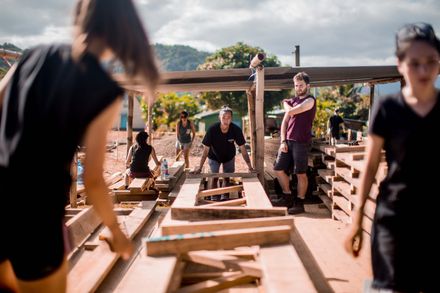Naidi Community Hall
ARCHITECTS
CAUKIN Studio
LOCATION
Naidi, Fiji
CATEGORY
Community Center, Sustainability
AREA
130 m²
YEAR
2018
PHOTOGRAPHS
Katie Edwards
LEAD ARCHITECTS
Harrison Marshall, Joshua Peasley, Alden Ching, Andrzej Bak
CLIENTS
The Naqaqa Giving Foundation, The Jazmin Fund, Naidi Village
DESIGN TEAM
Harrison Marshall, Joshua Peasley, Alden Ching, Andrzej Bak
ENGINEERING
Centrespace Design
INTERNATIONAL PARTICIPANTS
Maria Reyes Bariain, Emily Charlton, Maggie Dalton, Dinjal Damania, Lewis Danielson, Ksenia Davydova, Nikolina Georgieva, Kate Gonashvili, Maddie Griffiths, Ash Kendall, Cassie Li, Nikoleta Petrova, Richard Rothwell, Nadejda Tabakova, Connor Tulip, Lili Wagner, Sabrina Waibel, Janet Wong
PROJECT DONORS
The John Gore Organization, Fulton Hogan Hiways, Spratley & Partners, Centrespace Structural Design, The Pratt Foundation, Cristina and Liam Lynch Family Foundation, The Carl and Renee Landegger Trust, Vincent Hughes, Susan Rose, Stefan Berner, Sandra Elkins, Anna Miller, Andrew D. Perlman, Aaron Siegel, Anna L. Miller, Niamh Blancardi, Salma Aitali, Paul Isaacs, Claire Fordham
Text description provided by architect.
Naidi village, located on Vanua Levu in Fiji, had been without a community hall for 7 years when their previous community hall fell into disrepair and was deemed unsafe for use.
In the wake of this, the project came to fruition when a local NGO, the Naqaqa Giving Foundation approached CAUKIN Studio.
Serving a village of 400 people and 75 households, the hall’s main function was to provide a space for the community to come together for meetings, celebrations, funerals, and weddings. In Fijian culture, the community hall is the cultural and operational heart of a village.
With the collaborative influence of the community, it quickly became clear that the building must provide a space to sing, create local handmade crafts and perform their famous ‘Meke’ - a traditional Fijian dance.
CAUKIN Studio believes that having a safe, functioning, and beautiful space to express oneself creatively is vital to personal and community growth.
The design takes its form from theatre staging, crescendoing at its front facade, facing towards the centre of the village green.Three large counter-weighted, top-hung doors, open to create a stage playing host to performances of the village ‘Meke’.
Through the extended ceiling height, a natural flow of air throughout the building is increased, being released through hit-and-miss timber cladding under the roof eaves.This results in a space that can remain cool on the hottest days.
The opening shutters, louvre blades and large panes of glass create a naturally lit space internally, enhancing performances and events taking place within.The structure demonstrates the innovative design and cyclone resistance whilst still using only locally sourced materials, , thus allowing the project to be replicable by local communities in Fiji.
The building’s structural design was carried out by Centrespace Design,Who have supported CAUKIN’s work for the past 4 years.
The project construction took place over the course of 8 weeks, with a team of 20 international participants from architecture schools and practices, working alongside over 30 local workers.
The design was the result of a collaborative process that began 6 months prior to the project start date and included input from the community at every stage of the design development.
Much of the detailing and ongoing research happened concurrently with the project construction, ith all participants living with the families of Naidi Village and gaining experience and knowledge through cultural immersion
CAUKIN Studio worked in partnership with The Jazmin Fund, a charitable arm of the Naqaqa Giving Foundation to realise the project. The Jazmin Fund, run by Jazmin Grace Grimaldi, helped encourage a performing arts theme to the hall and its design.
The brief was to create a space that enabled the Naidi Community to express themselves creatively whilst providing a structure strong enough to take shelter - in the event of any future natural disasters.
Since completion, the hall has hosted local concerts, arts and crafts workshops every Wednesday, a reading hour every evening for the children as well as weddings and funerals. The handicraft salesmen and women have also recorded greater sales of their handmade souvenirs due to the new hall attracting more customers. In recent months the hall has become a registered kindergarten with 17 children in attendance every day.





















